How to Visit the Alhambra in 2024: 32 Insider Tips and FAQs

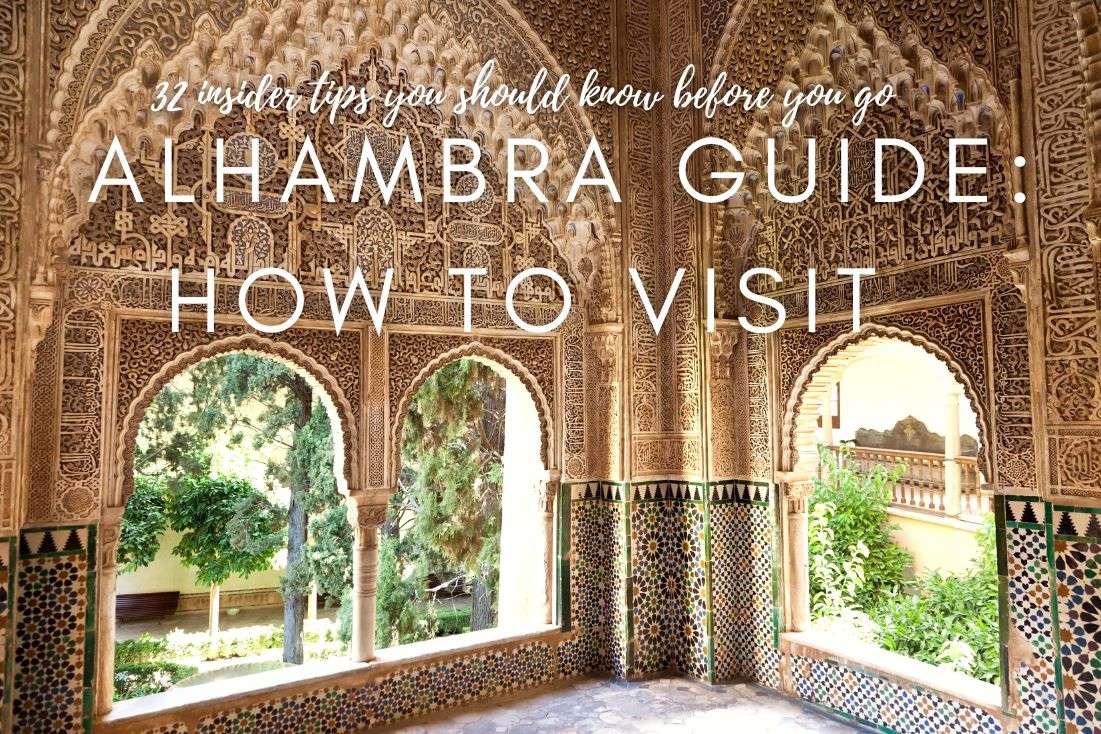
The main reason to visit Granada has always been, and will always be, the Alhambra. Without it, you could easily skip over Granada, maybe except for the free tapas, which enjoy a similar level of popularity here.
The Alhambra isn't just another castle/palace you visit; it's literally an architectural marvel and a testament to rich history. It's a sprawling complex where you can easily spend an entire day. If you don't have time for anything else in Granada, that's okay, but definitely don't miss out on the Alhambra when exploring Andalusia.
Before you head out, read my 32 tips and FAQs to get the most out of your Alhambra visit without any unpleasant surprises. Find out why the Alhambra is worth visiting, how to get tickets (and how not to make the same mistake I did!), how to get in and what to focus on, and a ton of information about the Alhambra’s history and significance. Also, you may be pronouncing it wrong...
Ready, set, Alhambra!
Tip: While you're in Granada, get inspired and read the article: 7 Top Things to See and Do in Granada, Spain.
You might also be interested in reading:
- 7 Top Things to See and Do in Granada, Spain (with Extra Details About the Alhambra)
- Andalusia Itinerary: Southern Spain in 10 Days
- Barcelona Itinerary: 5 days in Gaudí’s Metropole (with day trips)
- All You Need to Know about Spanish Tapas (+Restaurant Tips)
- The 10 Best Museums in Spain’s Top Cities
- The 16 Most Beautiful Beaches in Spain
What is the Alhambra and why should you visit it?
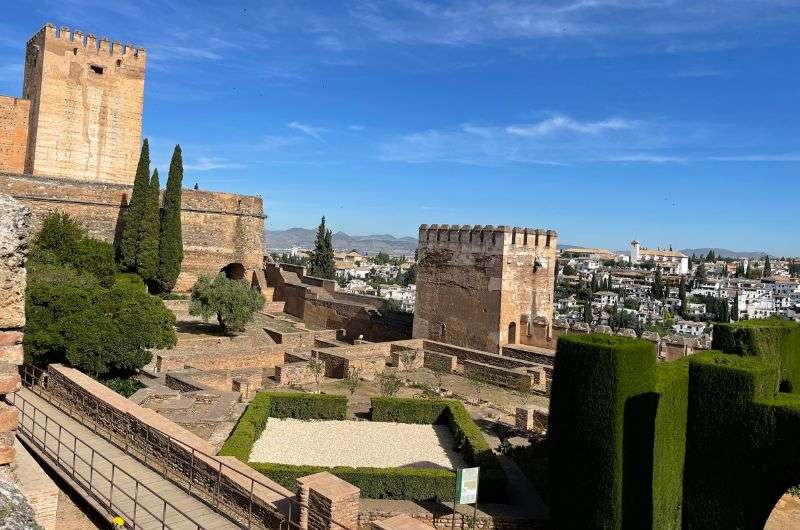
La Alhambra—the biggest Granada’s gem
1. What is the Alhambra and why is it famous?
The Alhambra is a stunning complex that served as the fortress for the rulers of Granada. The palace complex was constructed by the Arabs, specifically the Nasrid dynasty in the 13th century.
The Nasrids were a Muslim dynasty that ran the world, oh wait, those were girls (according to Beyonce)... anyway, the Nasrid dynasty ran Granada for 250 years, marking the last Muslim kingdom on the Iberian Peninsula. They built a luxurious palace complex on a hill, essentially creating a completely separate Muslim city from the rest of Granada. Basically, they were letting everyone know they were a cut above the "ordinary" folks. Throughout their reign, each ruler added their own touches until it became one of the best-preserved palaces of the historic Islamic world.
This Moorish idyll lasted until 1492 when Isabella and Ferdinand moved into the Alhambra without having to attack the Alhambra because the Nasrids just surrendered (they really had no other choice). Oh, wait... 1492, the same year of the rediscovery of the Americas, a coincidence? I don’t think so. If you're curious about who Isabella and Ferdinand are, you'll find a detailed history at the end of the article.
From just a photo, it's clear that we're talking about a truly massive complex. The Alhambra covers approximately 142,000 m² (1,528,475 square ft)!
The Alhambra has become a symbol of Granada and, by extension, Spain. Wondering why the Alhambra is important to Spain? Well, it's because of its beauty, history, and the exceptional combination of Moorish architecture and Andalusian culture. Simply put, the Alhambra is a mix of everything a country could wish for. I myself couldn't believe it has been preserved so well. It's a gem that every Spaniard can rightfully be proud of.
It's an impressive symbol of Spain's complex history, with rich architecture that harks back to the earlier settlement of southern Spain by other nations. The Spanish Renaissance has also left its mark, so aside from its original history, it carries a piece of Spain itself.
And as the cherry on top, the Alhambra and the Generalife Gardens are listed as a UNESCO World Heritage Site.
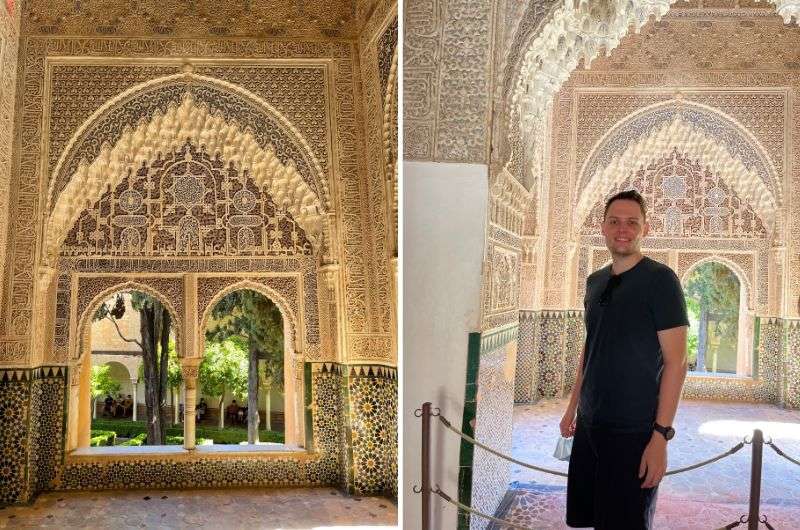
The beautifully decorated walls of La Alhambra, and me, adding to the charm
2. Is Alhambra its own city?
Not anymore, but the Alhambra used to be a buzzing hub back in the day. The Alhambra in Spain wasn't just a fancy palace; it was a whole mini-city with over two thousand souls living it up. Picture this: a classic Muslim town with everything you could think of—a Friday mosque, hammams (oh, reminds me of that one time I tried a hammam, but that's a story for another day), streets, houses, a bunch of crafty workshops, and get this, they even had their own water supply. Pretty cool, huh? Nowadays, though, it's just a historic site, part of the city of Granada.
Fun fact: There's actually a city named Alhambra in California. But the Alhambra I'm talking about is obviously in Spain. I mean, it'd be super convenient for my American readers if it was the Californian one, right? Just a short road trip away. But sorry folks, you won't find any Arabic fortresses in California (except the castle in Dead Valley).
3. How many people visit the Alhambra a day?
In 2022, the Alhambra was visited by around 2,700,000 tourists, with numbers rising every year. The number of people allowed in each day is limited, thank goodness for that, but it’s still almost 7,000 people daily. That's some serious traffic, making it one of the busiest spots in Europe. Introverts, beware! Hey, but still nothing compared to the average of 51,000 visitors per day at Disneyland (which, admittedly, is more than 10x the size of Alhambra).
Practical tips on visiting the Alhambra: When to go, how to visit, Alhambra tickets, and more
So, you're set on visiting the Alhambra, huh? Here are some practical tips to help you plan your trip smoothly.
4. What is the best time to visit the Alhambra?
Personally, I'd go for early spring. Everything's lush and green, the flowers in full bloom, and the trees offer a nice shade from the sun. Once again, early spring! Otherwise in spring and summer, you will be sweating there in a million degrees.
If you have a choice of day, weekdays are preferable. Weekends are universally crowded at attractions, and as you know, I'm not a fan of elbowing my way through crowds.
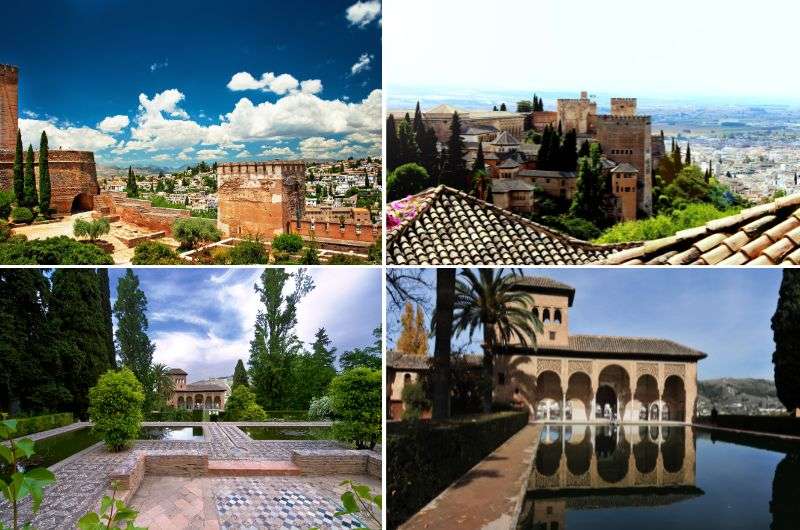
La Alhambra is beautiful all year round, but most bearable outside of summer
5. How long does it take to visit Alhambra?
The bare minimum for soaking up the Alhambra's vibe is 3 hours. That's if you're not the type to dilly-dally or get caught up staring at every little detail. But let's be real, you could easily spend way more time there, depending on how long you want to marvel at the frescoes, ornamental walls, gardens, and whatnot.
Planning to snap pics of every single corner of the Alhambra you stumble upon? Then you might as well block off a good 5 hours for your visit. Trust me, with so much beauty around, you'll want to capture it all! And to be honest, you don’t need that much extra time for Granada’s other tourist sites, so it’s fine either way.
Hotel tip in Granada: If you really want to stay the night in Granada—though I think it’s unnecessary—try Hospes Palacio de los Patos. You'll feel like royalty there, though after visiting the Alhambra, it might not seem as majestic. What I wholeheartedly recommend is to base yourself an hour away at the incredible, the unmatched, the one that oozes serenity, the best hotel we stayed at in Andalusia: Hacienda Fresneda María.
6. Where is the best place to enter the Alhambra?
The Alhambra unfolds into three main sections: the Alcazaba (the fortress), the Nasrid Palaces, and the Generalife (the gardens). And let me tell you, each spot has its own tale to whisper. I'll dive deep into each area in FAQs 19–24, so keep your eyes peeled for those!
As you meander from one breathtaking area to another, keep your ticket and passport handy. They'll check them as you enter each section. Picture this: 300 folks trying to squeeze into the Nasrid Palaces during each slot. Yeah, it's a bit like being stuck in "ticket traffic" during rush hour.
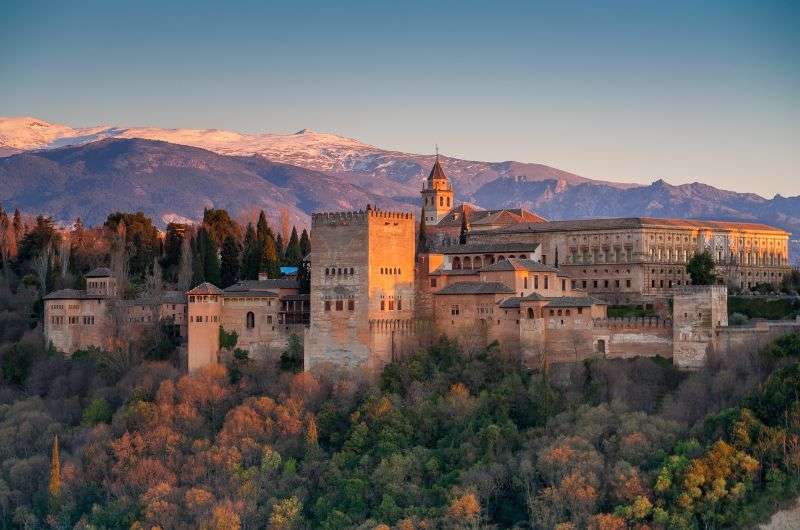
View of La Alhambra and the mountains of Granada
Kicking off your Alhambra adventure? Head to Plaza Nueva and walk down Cuesta de Gomérez. This charming street leads you to the Gate of the Pomegranates (Puerta de las Granadas) and straight to the Justice Gate (Puerta de la Justicia), which is the official entrance to the Alhambra. You will be walking through an avenue surrounded by trees and some fountains for about 0.7 miles (1100 km).
There are more ways to walk up, namely the Cuesta del Rey Chico, o de los Chinos, that leads up to the back of the Alhambra through a more of a forest landscape. It’s a good route to take back down to the city if you end your walk through the Alhambra in the Generalife gardens.
The Alcazaba is at the bottom of the Alhambra right next to the Nasrid Palaces.
Then you continue to the Generalife is known as the place to admire the Alhambra gardens, though there is actually a palace up there too. Since the Generalife is way up top, you’ll want to either start or end your tour there.
7. Do I need to buy Alhambra tickets in advance?
If you're aiming to step inside the Alhambra and not just stare at it sadly from outside the gates, then absolutely yes, buy tickets in advance. And for all you notorious planners out there, I've got some good news—actually, make that two pieces of good news. First, you're in the same boat as me; and second, tickets can be bought up to three months in advance.
Kick back, reserve your tickets from the comfort of your home, and bask in the peace of mind knowing your spot is secured... But there's a slight catch. Tickets are tied to a name and specific date, so if your plans drastically change along the way, you'll lose out on the cash you shelled out. But who changes meticulously crafted plans, right?
Should there be a need to change the ticket holder's name within a group of five to nine people, it's doable to change one name. So, if you're a family of four or a group and someone falls ill, unfortunately, you can't just hand off the ticket to someone else on the fly.
Funny story: Buying a ticket to the Alhambra can feel like a bit of an ordeal. It was for me since I only realized I bought two tickets for a totally random date after paying for them. Double and triple-check all the information on the last page before hitting confirm, even if you’ve checked the info on the pages before that. Trust me, I learned this the hard way and it cost me an extra €28. But wait, there’s more to prove that even I make the stupidest mistakes. In the end, I forgot my passport, so I had to buy yet another ticket. Yes, for the third time. I mean it was not even funny by that point.
8. How much does it cost to go to Alhambra Palace?
Make sure to buy your tickets on the official Alhambra website (be warned that there is another website that looks very official, but they only sell guided tour—don't fall for it!). With the soaring popularity of this historical jewel, a bunch of sketchy sites have popped up aiming to make a quick buck off unsuspecting travelers. So, a word to the wise: keep your eyes peeled to avoid getting duped. Nothing ruins a vacation faster than being turned away at your dream destination because your tickets are as real as a mirage. Just use this link, and you're golden.
The Alhambra offers a few different ticket options. The most common ticket costs EUR 19.09 and grants you access to the Nasrid Palaces, Generalife, and Alcazaba. Another popular pick is a pared-down ticket for EUR 10.61, which lets you into Generalife and the Alcazaba but skips the Nasrid Palaces—big mistake, since the Nasrid Palaces are the absolute crown jewel of the Alhambra.
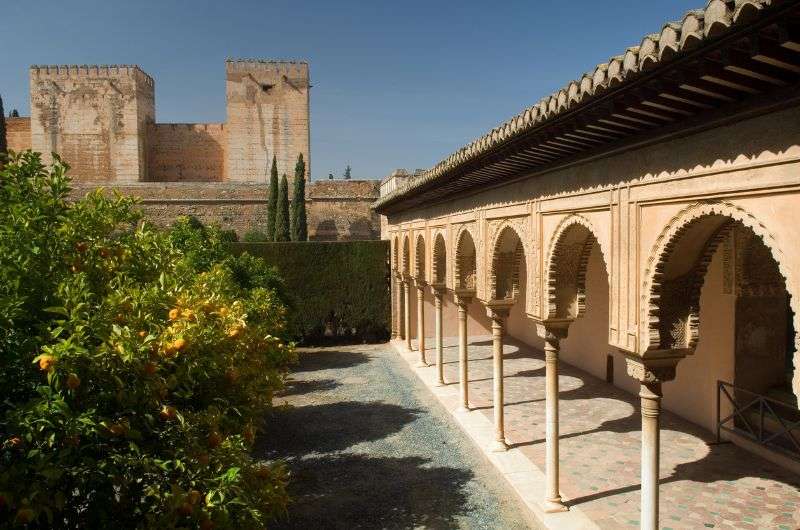
Get the full day ticket to see the Alhambra, and don’t even think about leaving out the Nasrid Palaces! I’m not sure who that ticket option is for... fools?
For those chasing a bit of romance or maybe even ghosts, Alhambra's night tours might catch your eye. One option, priced at EUR 10.61, opens the doors of the Nasrid Palaces to you under the moonlight. Another slightly cheaper option at EUR 7.42 lets you wander through the Generalife and its gardens by night.
If you're planning to hang around Granada for a night, I'd recommend the two-day ticket for EUR 19.09. This deal includes a daytime visit to the Alcazaba, Gardens, and Palaces of Generalife, plus a nocturnal adventure in the Nasrid Palaces. Just remember, you can't cram both visits into a single day, so make sure you're spending at least one night in Granada. If you meet this criterion, it's a no-brainer.
Tip: Wondering where to stay in Granada? Once again, here's my recommendation: Hospes Palacio de los Patos.
But Granada isn't all about the Alhambra. If you're keen to dive deeper into Granada's history, there's a ticket that also includes entry to various other historic buildings around the city. For EUR 27.30, you get daytime access to the Nasrid Palaces, Alcazaba, and the Generalife within the Alhambra, plus Dar al-Horra Palace, Bañuelo, Chapiz House, Zafra House, Horno de Oro, and the Royal Quarters of Santo Domingo scattered throughout Granada.
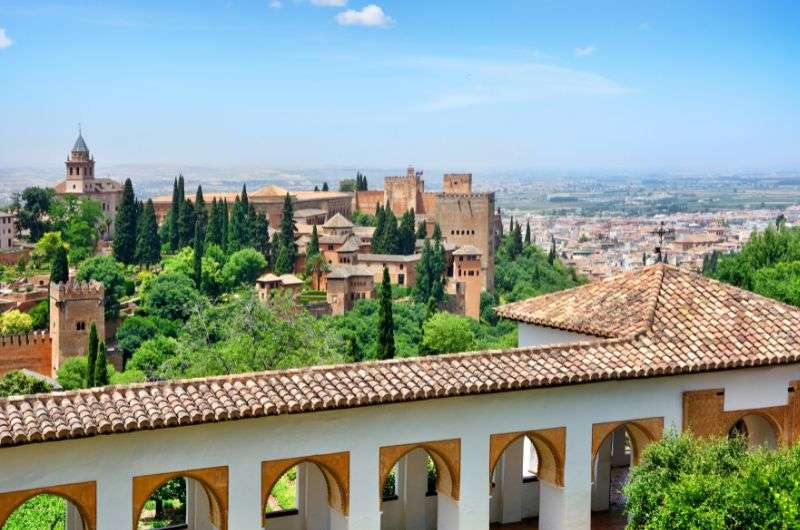
The Alhambra
9. Can I enter Alhambra at any time?
The Alhambra is open nearly every day of the year except for January 1st and December 25th. Operating hours vary depending on whether it's the winter or summer season. And just to hammer it home because it's super important: tickets are tied to a specific date. If you get a ticket to the Nasrid Palaces (which you absolutely should because it's the crown jewel of the entire place), you're also locked into a specific entry time for just the Nasrid Palaces. Miss that window, and you're out of luck to get in. So, plan your exploration of the rest of the complex accordingly.
Alhambra daytime opening hours:
- October 15th–March 31st open daily 8:30 am–6:00 pm
- April 1st –October 14th open daily 8:30 am–8:00 pm
Alhambra nighttime opening hours:
- October 15th–March 31st open daily 8 pm–9:30 pm
- April 1st–October 14th open daily 10 pm–11:30 pm
10. Can you see Alhambra without a guide?
Absolutely, you can do a self-guided tour of Alhambra. Ticket prices are solely for admission and don't include a guide. But nothing's stopping you from arranging your own tour guide. It all depends on what you're looking to get out of your visit. If you're keen on digging deeper into the historical and cultural insights than what I've covered in this article, then having a tour guide will definitely enhance your experience.
11. Can you drive to Alhambra?
The Alhambra is a hot ticket in Granada, and the locals are well-prepared for the influx of visitors. If you decide to drive there, rest assured, there's a sizable parking lot waiting for you. Just factor in about a 10-minute walk from the parking lot to the entrance. Parking rates are set at EUR 2.35 per hour.
Tip: And hey, while you're in Granada, why not take a drive to Malaga? I've got you covered with the Top 20 Tips For Malaga: Places To Visit, Seafood, Brunch, Tapas, and More.
Another way to reach the Alhambra from Granada is by public transportation. Buses number 30 and 32 head straight from the city center and drop you off right at the main entrance.
The last option is to go to the Alhambra on foot from the city center. As I've mentioned before, the Alhambra sits atop a hill. So, if you opt for a walk, brace yourself for a bit of a climb. Combined with the temperatures that reign over southern Spain for most of the year, you're in for a sweaty journey. But on the upside, you get to choose from three different routes to the top, and that's worth considering.
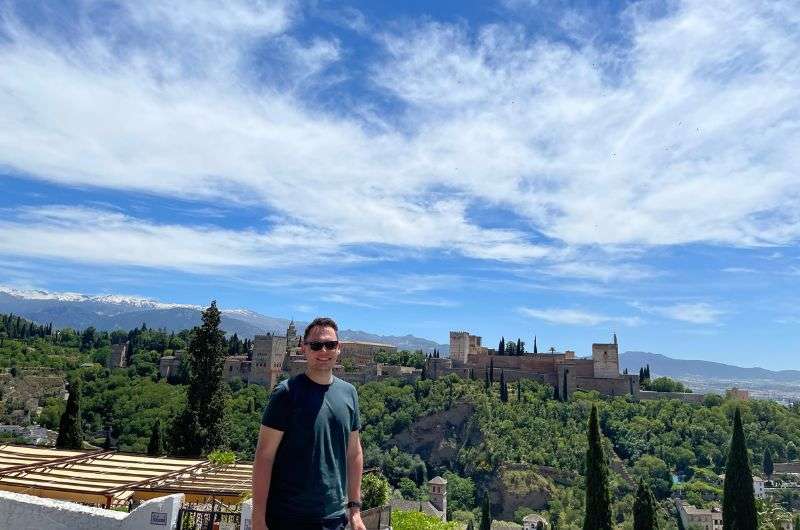
Alhambra views never get old
12. Does the Alhambra have a dress code?
All visitors to the Alhambra must wear tight leggings and tank tops. Did I scare you? Just kidding! No worries, there's no dress code for the Alhambra. However, if you plan to visit the local church within the Alhambra grounds, you'll need to cover your shoulders and knees. So, keep this in mind when packing for your trip and perhaps throw in some long pants or a skirt. This rule applies to both men and women.
13. Do you need a passport for Alhambra?
At the entrance to the Alhambra, you'll need to show some ID, so have your passport or national identity card ready (along with your ticket). As I've mentioned before, tickets are tied to your name. If you're an EU resident, an ID card will do the trick, but everyone else should bring a passport. And if you're bringing kids along, make sure to have some form of identification for them too, to verify their age upon entry.
14. Are kids allowed at Alhambra?
Kids are totally welcome at the Alhambra. If they're under 12, they even get in for free, but you still need to "buy" a ticket for them too. Since the Alhambra has a cap on the number of daily visitors, this ensures they're counted in the headcount. Heck, sometimes, I’d even count one kid as two adults! So, you'll need to count your kids before you leave for your Andalusia trip and buy tickets accordingly.
You'll also need to bring proof of your child's age. If your child is under 8, the rules say you should hold their hand throughout the visit (yes, it's actually a rule!). I know, sounds like a hassle. Try to at least stick to this in indoor areas to avoid any run-ins with security.
Planning to visit the Alhambra with a stroller? Here's a bummer: strollers are a no-go inside, and you'll have to leave them in the cloakroom at the entrance. But they'll lend you a child carrier for free in exchange. So, brace yourself for a bit of back pain and off you go!
Tip: If you are coming to Granada with kids, you won’t be able to stay at Hacienda Fresneda María, the hotel that I recommend everywhere I go. It’s adults only, but I can’t say I am mad at the rule! It was Just. So. Peaceful!
15. Are backpacks allowed in Alhambra?
Visiting the Alhambra is a bit like dealing with carry-on luggage on a flight. Bags larger than 40x40 cm (15.7x15.7 inches) have to be checked into the cloakroom. If you're bringing a smaller backpack, you'll need to wear it in front the whole time to avoid accidentally damaging anything. Ideally, try to avoid bringing a bag at all.
16. Can you bring water into Alhambra?
Sure, you're allowed to bring water (any kind of sealable bottle) and some snacks into the complex. Eating and smoking are permitted, but only in designated areas scattered throughout the grounds.
If you've forgotten your water bottle, please, for the love of history, don't drink from the fountains, haha. There are drinking fountains and vending machines all over the place for your hydration needs, plus cafes and a restaurant. So chill, you won’t go hungry (or dry).
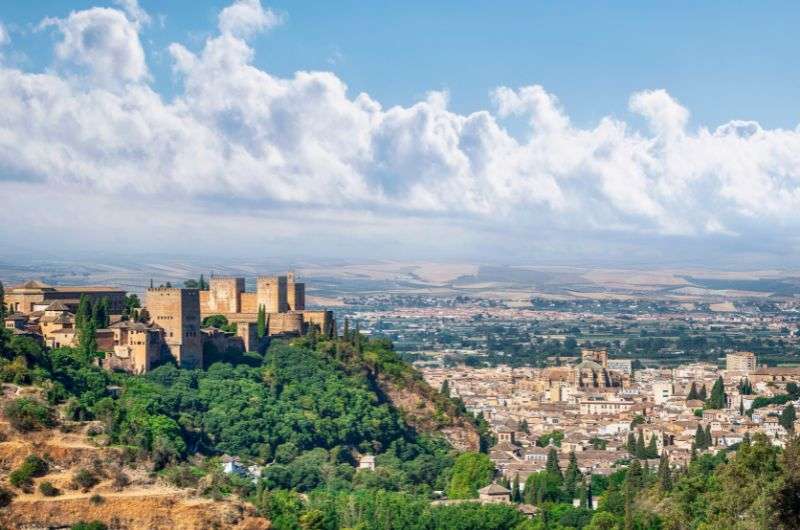
The Alhambra
17. Where is the best viewpoint of the Alhambra?
The best views of the Alhambra are famously captured from Plaza de San Nicolás in the Albaicín neighborhood. But since it's the most well-known lookout point, there's a good chance you'll be jostling for space with a crowd, potentially blocking your view.
I went full detective mode for you and uncovered a hidden gem of a viewpoint that's (almost) off the radar. Give San Miguel Alto a shot. Sure, it's a bit of a hike, but the payoff? Absolutely breathtaking views. Another secret spot is Carmen de la Victoria. Here's the twist: it's owned by the University of Granada. What's the catch? You've gotta knock to get in.
Or you could simply stay at the Carmen de Vidal hotel, which offers a stellar view of the Alhambra too. At Barceló Carmen Granada, you can get sneak peaks at the Alhambra while you soak in the rooftop pool.
18. What are the characteristics of the Alhambra Palace?
Given its status as a refuge for Moorish kings, no expense was spared in the decoration of the Alhambra. You'll find stunning frescoes on the ceilings, ornate columns with monumental arches, decorated walls, and notably, a spot where you can witness the evolution of Moorish architecture.
Moorish architecture bears similarities to Islamic style but also incorporates plenty of European elements. A distinctive feature is the arches; it seems the Moors were obsessed with them, as they placed arches everywhere possible (gates, windows, arcades). Another hallmark of Moorish architecture is the decorated walls, adorned with various patterns, reliefs, or colorful tiles.
Personally, what I find fascinating about the Alhambra is how it seems a bit out of place. Perched on a rugged hill, there's a magnificent structure above the city of Granada that draws thousands of tourists daily. It doesn't hurt that the Alhambra continues to be shrouded in various legends and mysteries.
What to see inside the Alhambra—Details of each section
The Alhambra can be segmented into 6 distinct parts, each historically constructed in succession. The biggest draw is undoubtedly the Nasrid Palaces and, for me, definitely the Generalife Gardens. Beyond these, there's also the Charles V Palace (built after the Catholic monarchs took over the Alhambra), the original fortress La Alcazaba, Medina, and the royal cemetery Rauda.
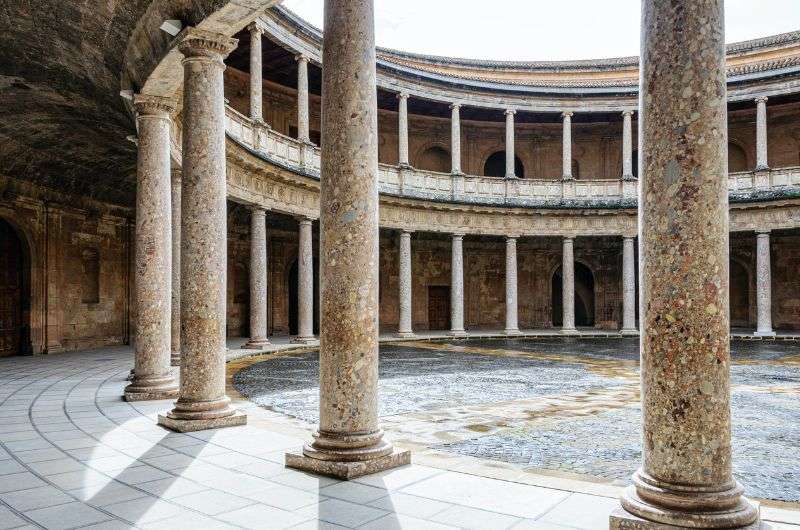
Explore the interiors of La Alhambra
19. What’s inside: Charles V Palace
The construction of this palace kicked off in the 16th century, commissioned by none other than Charles V of the Habsburgs, lending the palace its name. Charles V had a flair for style and aimed to preserve the beauty of the Arab palaces, intending to pass down a perfect piece of work to future generations. Interestingly, the palace didn't serve him for too long, as the royal court's activities eventually shifted to Madrid, and poor Charles V Palace was left in the dust. It was forgotten until the late 20th century when it finally got a roof over its head and became home to museums. You'll find two there: the Alhambra Museum on the ground floor and the Fine Arts Museum above it.
Tip: Speaking of museums, here's The 10 Best Museums in Spain’s Top Cities. Each and every one is worth a visit!
The palace itself has a square floor plan, with each side measuring 63 m (206.7 ft) and reaching a height of 17 m (55.8 ft). If geometry is your thing, you'll be in heaven. At the center of this massive square is a circular courtyard with a diameter of 30 m (98 ft). The entire palace is a Renaissance masterpiece.
Despite the construction facing numerous hurdles and dragging on for almost 400 years, I think it turned out pretty spectacular. I'd happily make this my getaway spot. And if I wanted to ride in on horseback, I could just park my steed in the courtyard! But I’m allergic to horses, so I’ll take my car, thanks. When you visit, notice the bronze rings inserted into the columns—they were used to park horses.
20. What’s inside: Medina Alhambra
The original Medina was in the eastern part of the Alhambra, but due to the Napoleonic Wars, it was destroyed, leaving only ruins and some reconstructed buildings. The Medina was essentially a mini-city filled with mosques, shops, baths, residential areas, toilets, and workshops. It served the daily needs of those who worked within the Alhambra. A main street known as Calle Real (King's Road) ran through the Medina, parts of which still exist today.
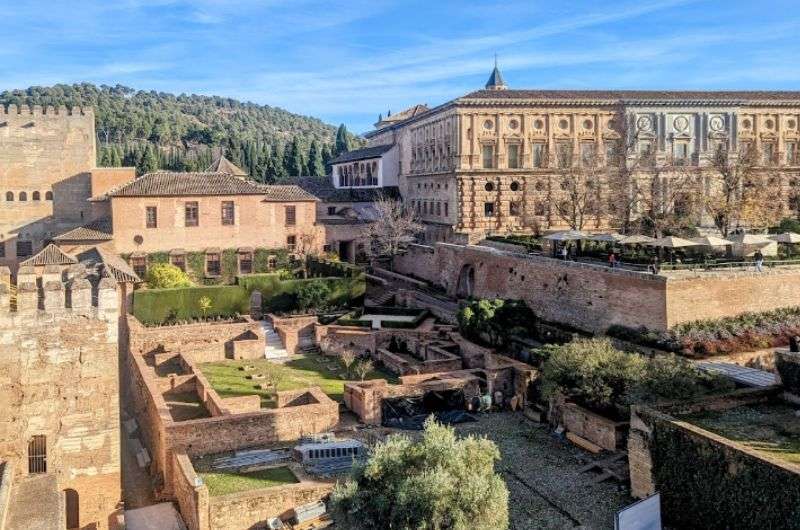
The Medina in the Alhambra
So, during your visit, in addition to the remnants of the royal road like the Wine Gate, the Towers of Abencerrajes, or the Seven Floors Tower; you can also explore the foundations of buildings, the walls from the inside of the fortress, and the battlements with loopholes offering views of the Generalife. It's a real pity that this part didn't survive intact; from what I've seen, it could’ve been incredibly fascinating.
21. What’s inside: The Nasrid Palaces
The palace complex, composed of three palaces: the Palace of Comares, the Mexuar, and the Palace of the Lions, is named after the last Arab rulers, the Nasrids. And let me tell you, touring it will make your jaw drop. It's just a “wow” experience. For me it is definitely the most stunning part of the Alhambra complex.
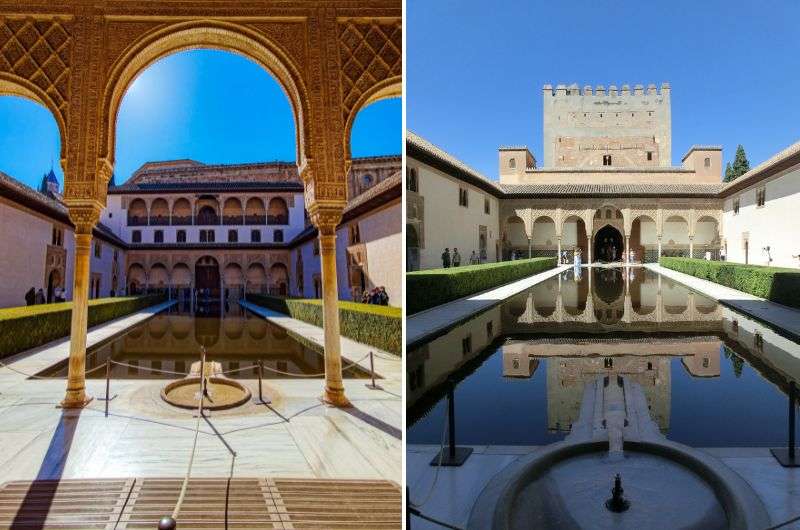
Nasrid Palaces
While the Palace of Comares served as the official residence, the Palace of the Lions was designated for the Harem. Those sultans back then really knew how to live it up—an office in one palace and another palace for their extensive array of wives. The functionality of each palace is also reflected in its decoration.
The Palace of Comares is adorned in a typically Muslim style, but the Palace of the Lions shows the influence of Christianity. It's a bit of a paradox since Christians aren't exactly big on polyamory. However, the reigning sultan at the time, Mohammed V, maintained a close friendship with his Spanish counterpart, Pedro I, leading historians to believe that's why the palace sports a different style.
The Mexuar functioned as a sort of entry hall to the Palace of Comares, primarily hosting administrative activities. It consists of four main parts: two courtyards, a meeting hall, and the Cuarto Dorado with a courtyard. The Cuarto Dorado acted as the connector to the main palace, where visitors waited to be received by the sultan.
22. What’s inside: Rauda Alhambra
Rauda was the royal cemetery, plain and simple. It served as the final resting place for the remains of the Granadan monarchs during the Moorish reign. In recent years, the cemetery has undergone partial reconstruction to highlight its original context.
23. What’s inside: Generalife
The Generalife served as a summer retreat for the Sultans, located north of the Alhambra. I can see why they loved it so much! True to its purpose as a summer residence, the Generalife boasts gardens, a colonnade, and fountains, representing one of the best-preserved examples of a Persian garden in Spain. It was historically built before the Palace of Comares.
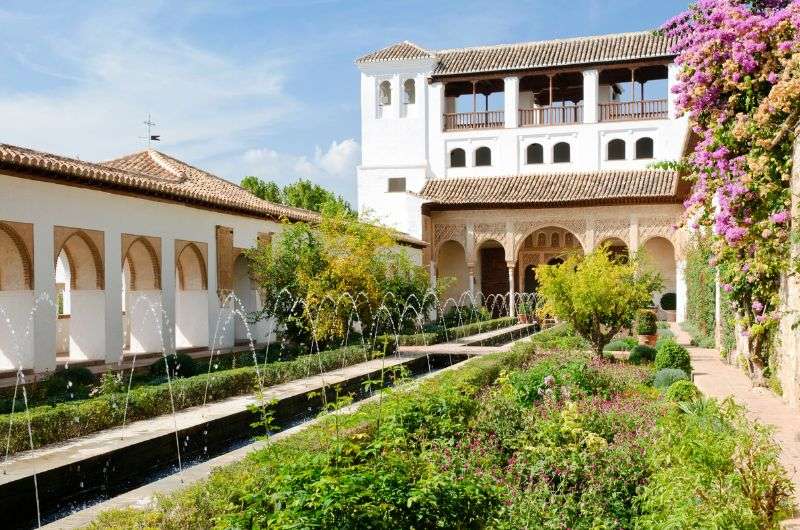
Persian garden in Generalife
Originally, it was connected to the Alhambra by a crypt, which has not survived to this day. If you're a fan of mosaics, wandering through the gardens will be a treat, as mosaics are everywhere. The pathways are crafted in the traditional Granada style, paved with river stone mosaics.
What you see today is not its original form; over the years, the Generalife has undergone numerous modifications, depending on the whims of its caretakers. But still, the gardens are insane, with fountains and pools and just overall awesomeness. I'm telling you, you'll end up taking more photos here than you thought possible.
24. What’s inside: La Alcazaba
La Alcazaba likely stands on the foundations of a Roman fortification. It was a fortified military complex, hence the name, since "qasaba" means fortress in Arabic.
Historically, it's the oldest part of the Alhambra, but personally, I find it the least interesting part of the entire complex. The origins of the Alcazaba date back to the 9th century. Over the years, it underwent expansions, such as during the reign of Mohammed I, when three new towers were completed. During the French occupation, the Alcazaba served as a prison.
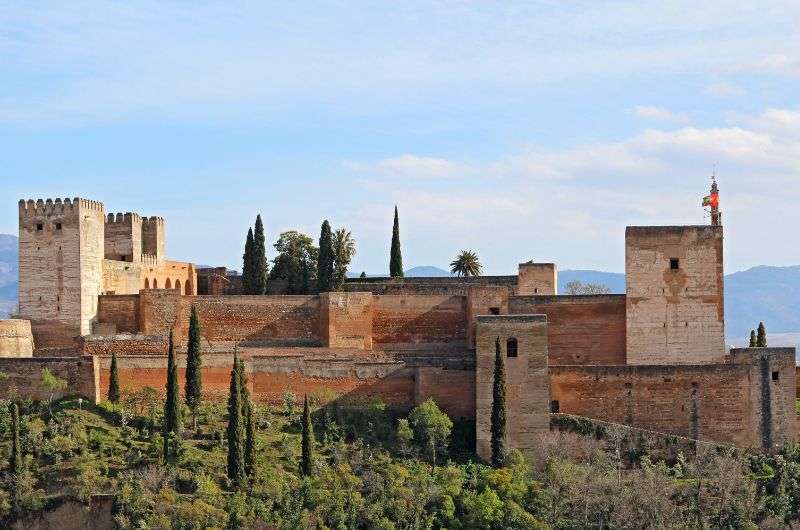
La Alcazaba
Fun facts about the Alhambra
Here are a few interesting tidbits about the history, the name "Alhambra," and other facts that are intriguing, though knowing them isn't essential for enjoying your visit to the Alhambra. Well, except for the history part—that's pretty fascinating.
25. What religion built the Alhambra?
As I've mentioned before, the Alhambra was built by the Moors (Arabs), specifically by the Nasrid dynasty, the last Muslim dynasty to rule in Spain.
Here's a little educational nugget for those not versed in religion: Muslims are followers of Islam, a monotheistic religion founded by the prophet Muhammad. Their holy book is the Quran. Arabs are an ethno-linguistic group, the majority of whom are Muslims. But it's important not to lump them all together. Besides Islam, there are minority religions within the Arab world, including Christianity and Judaism.
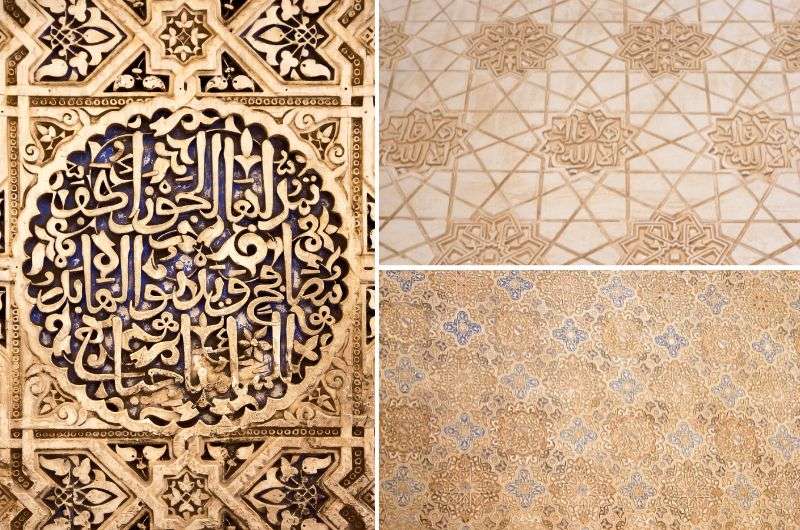
Decorations on the facades of the Alhambra
The origins of the Arabs trace back to the Arabian Peninsula, the world's largest peninsula. From there, in the 7th and 8th centuries, they began to migrate across the globe (at least, the parts not separated by sea). In a relatively short period, they reached Southern Europe, North Africa, and Central Asia.
26. What is the Alhambra made of?
Get ready for this, here comes the reveal about the Alhambra’s red color: Those who paid attention during chemistry class in elementary school might have a hunch. The red hue comes from iron oxide, aka rust. So, you could say the Alhambra is rusty.
The oxides are just natural impurities in the clay from which most of the Alhambra is built. Besides clay, stone and lime were also used in construction. These aren't exactly the strongest materials, but the workers were savvy to this and compensated with the thickness of the walls. Notice that when you walk through doors in the Alhambra, the walls are always at least a meter (3 ft) thick.
27. What is the story behind the Alhambra?
The history of the Alhambra dates back to the 9th century, specifically to the year 889, when a fortress (Alcazaba) was built on the hill to serve as a defensive position protecting the Muslim emirate from potential external threats.
For the next four centuries, the structure remained untouched. It wasn't until the 13th century that the Nasrid dynasty began expanding the Alhambra into the palatial complex we know today. The famous Nasrid Palaces, including the renowned Palacio de Comares and Palacio de los Leones, were constructed in the 14th century. These palaces showcase exquisite Islamic architecture and intricate decorations.
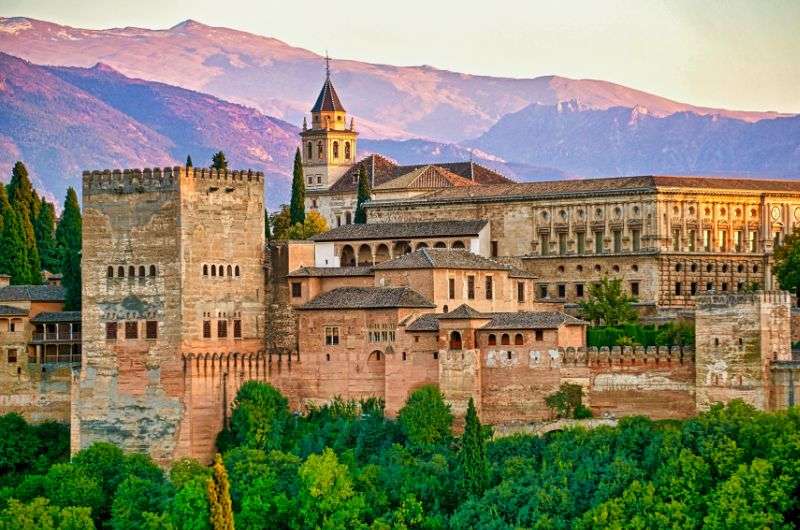
The Alhambra was build in 889
As I've mentioned, the complex didn't remain under Arab control throughout its history. In 1492, the Catholic monarchs, Isabella and Ferdinand, conquered Granada, marking the end of Muslim rule in the area. The Alhambra then became a royal palace for Catholic kings.
In the 16th century, Charles V, Emperor of the Holy Roman Empire and King of Spain, commissioned the construction of the Palacio de Carlos V within the complex, introducing a Renaissance style. You can imagine the stark contrast this presented to the surrounding Islamic architecture. Charles V was the last to actively build on the Alhambra for a while, as it then fell into neglect for two centuries.
It wasn't until the 18th and 19th centuries, with the rise of the Romantic movement that emphasized a love for nature and history, that Granada, and especially the Alhambra, became symbols of romantic ideals, inspiring artists, writers, and adventurers. It's fair to say the Alhambra was rediscovered during this time.
Throughout the 19th century, the Alhambra was opened to the public, and in the 20th century, it was declared a national monument and listed as a UNESCO World Heritage Site.
28. Who is buried at the Alhambra?
Right now, nobody, but under Arab rule, the Alhambra had two cemeteries. One was to the south of the fortress, outside the fortified area, where Muhammad I al-Ahmar (the first ruler of the Emirate of Granada) and two of his grandsons were buried. The other cemetery— Rauda—was the final resting place for other Nasrid rulers and their families.
However, after Granada was conquered by the Catholic monarchs, Abu Abdullah Muhammad XII, the last ruler of the Emirate of Granada, moved his ancestors' remains to a country estate in Mondujar. But in 1574, surprise, surprise—it turned out he didn't quite catch all his forebears, and during the construction of the Palace of Charles V, four tombs were discovered. Today, three of those tombs are at the Alhambra Museum—belonging to the sultans Muhammad II and Yusuf III, and the third to Prince Yusuf.
29. Why is Alhambra a UNESCO World Heritage Site?
The Alhambra and the Generalife Gardens were added to the UNESCO list in 1984, precisely because there's nothing quite like this complex anywhere else in the world. And honestly, I have to agree. Sure, UNESCO had its own criteria for evaluation, but even a layman could tell at first glance that the Alhambra deserves its spot of honor.
Fun fact: it was among the very first Spanish structures to be inscribed on the UNESCO list. The year 1984 marked the debut of Spanish landmarks on the list.

Alhambra is a UNESCO World Heritage Site
Tip: The Alhambra isn't the only spot in Granada to make it onto the UNESCO World Heritage list. The historic Albaicín quarter, which served as home to Moorish residents after the Catholic conquest of Granada, is also recognized. Check out my 3-Day Itinerary for Malaga and Granada to discover all the intriguing spots this part of Andalusia has to offer.
30. Is the Alhambra a world wonder?
If someone asks me, I'd unequivocally say yes. But when the decision was being made, no one thought to consult me.
Before 2017, there was a list of the Seven Wonders of the World, which many of you might have learned about in school. Apart from the Pyramids of Giza, which are still standing, it featured another six constructions, some of which historians are still not sure ever existed.
Due to this, in 2000, the "New 7 Wonders of the World" poll was initiated, attracting over 100 million voters. Based on this poll, a new list of seven wonders with the highest number of votes was created. Unfortunately, the Alhambra didn't make the cut. Such a shame. I can't fathom how the somewhat dilapidated Colosseum in Rome made it onto the list, but not this marvel.
I read somewhere that it made it onto the list of the Seven Wonders of the Muslim World. So, at least someone gave the Alhambra the recognition it deserves.
31. What does ‘Alhambra’ mean?
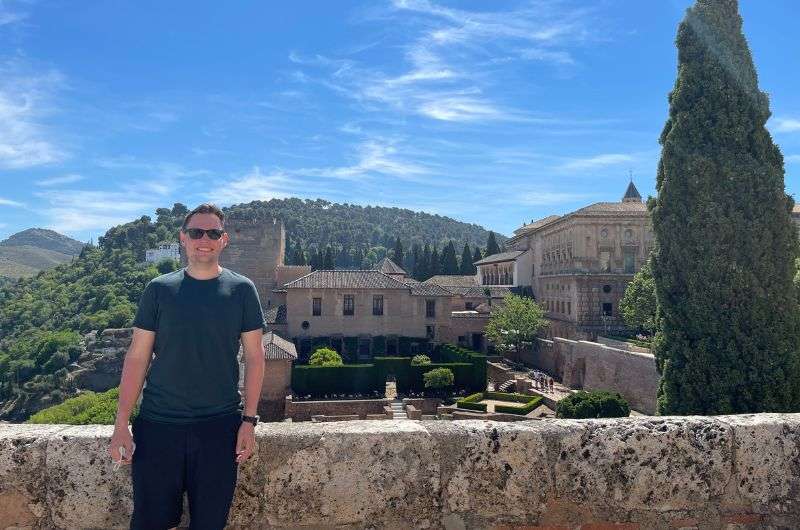
Etymological window
The etymological origin of the name stems from Arabic, echoing the founders of the Alhambra. In Arabic, "Alhambra" means “the red one”. The original name was Qatal Alhambra, translating to “the red fortress,” but for some reason, only the shortened version stuck.
If you're more linguistically gifted than I am and have a basic knowledge of Arabic, you probably know that "Al" is simply the definite article. It historically just worked out that it’s used with the article. Personally, Alhambra sounds better than just Hambra, and I don't even have a poetic bone in my body.
Most of us (unless you're from China, where red is considered a lucky and joyful color) associate red with the color of blood. In this case, though, that's not the angle. It's all about the color of the walls, which are red due to the materials used.
32. How do you pronounce ‘Alhambra’?
For me, it's easy; I just read it as it's written. That's how we Czechs do it. But since you English speakers might struggle with this, here's a phonetic breakdown that makes no sense to me: ahl-ahm-bruh. Most importantly, the "h" is silent, so there's no "ham" in Alhambra.
And speaking of ham, do you know the difference between jamón and chorizo? I've tackled this immensely important question in my article on Traditional Food of Spain.
This post contains affiliate links. I earn a small commission if you make bookings through my links, at no additional cost to you. Thank you for your support!
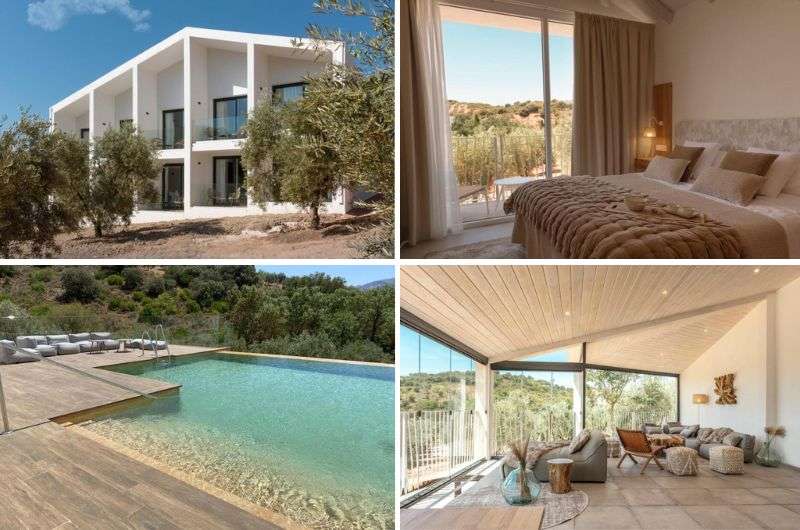

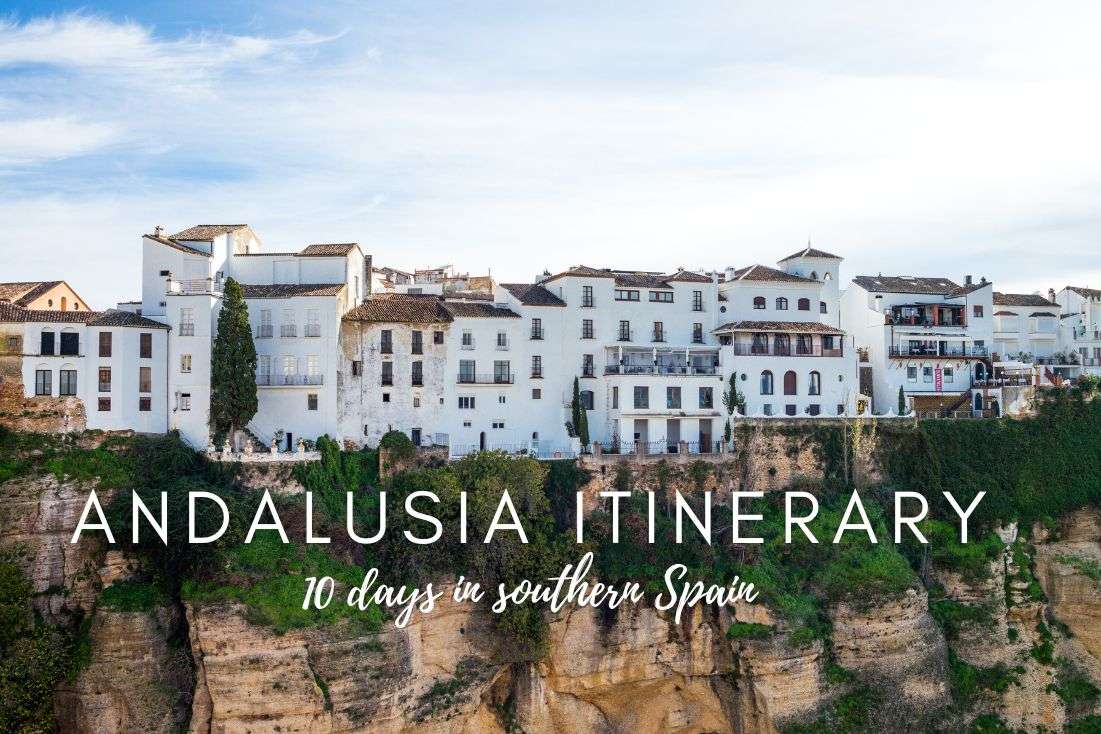
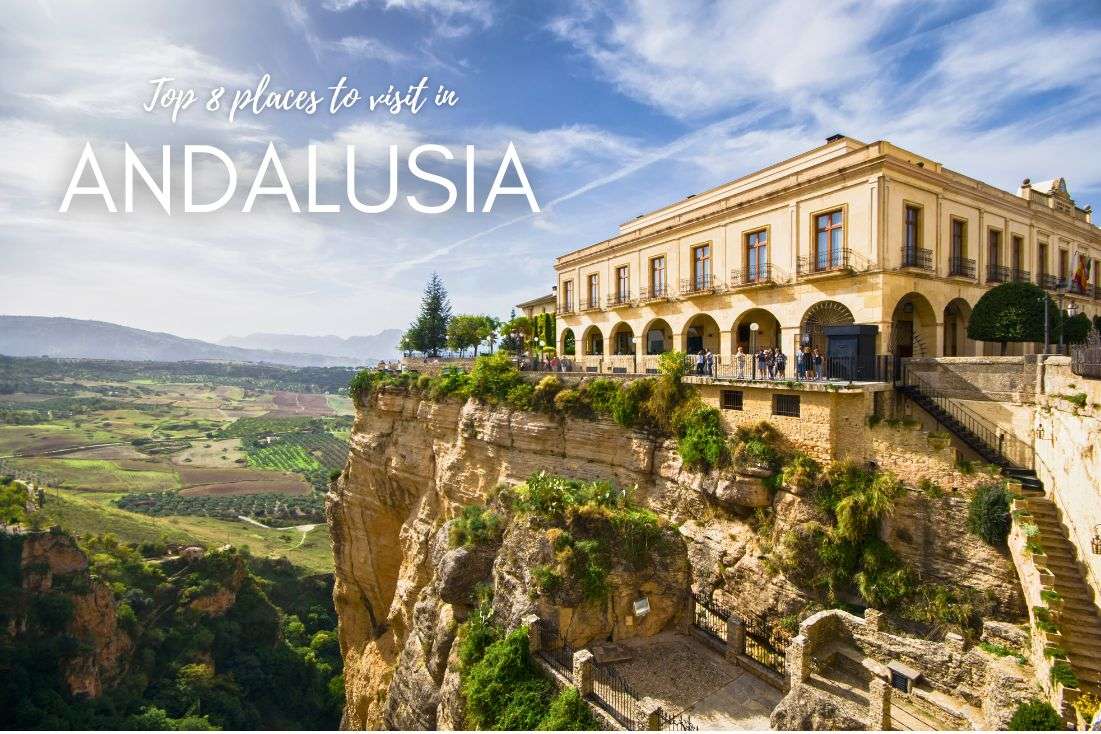




Comments
Thoughts? Give us a shout!